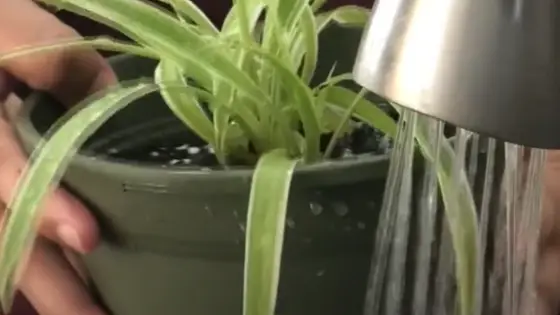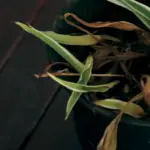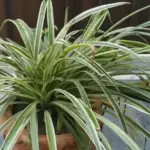Have you ever asked yourself: How Often Do You Water a Spider Plant? Now, I don’t know why you wouldn’t have before (although, I’m not sure where you’re getting your spider plants) but that’s besides the point. The point is, if you’re looking for answers to this question, then this is the article for you!
When it comes to watering a Spider Plant, how often should you do it?
If you’re new to gardening or simply want to bring some greenery indoors, I highly recommend spider plants because of how simple they are to care for. Cacti are highly recommended by a lot of people, but I don’t share that opinion for two reasons:
- Beginners frequently drown their plants in an attempt to keep them alive, which can quickly kill some types of cactus. Watering spider plants is simple and enjoyable.
- Because of how slowly cactus grow, there is typically no noticeable difference from one week to the next with most of them. Because of this, the thrill of your new hobby may be diminished. On the other hand, a spider plant matures quite rapidly, which makes observing its growth a really satisfying experience.
I should clarify that spider plants do have a hard time thriving in some environments. They can also just survive in particular circumstances. They may perish under certain situations, such as root rot, which happens when plants are overwatered over a lengthy period of time.
Spider plants produce plantlets that adhere to the parent plant. These may simply be used to propagate new plants for your home and yard. You might grow them in little containers to give as presents that are simple yet memorable.
Read more: Why Is My Spider Plant Pale And Limp?
Table of Contents
How Often Do You Water a Spider Plant?

This issue has no definitive response due to the fact that the amount of water required depends not only on location and soil type, but also on the time of year and the growth stage.
Have no fear, though, because the purpose of this article is to assist you in determining the exact amount of water that your plant needs.
- The pot’s size and type
- The humidity level in the location where it is planted
- The soil’s ability to retain moisture.
- Season of the year.
- Pot Type
Smaller pots dry out considerably faster than larger ones, so choose pots that are somewhat larger than your spider plant. A large container not only supports the growth of plants but also helps the soil to dry out at the ideal rate.
Ensure that the chosen container has drainage holes. By removing the extra water, you may help avoid root rot. Unfortunately, while drainage holes in containers assist in avoiding waterlogging, they can also remove the soil with the water.
To prevent this from happening, just place a coffee filter over the drainage holes. This will allow the water to flow away while maintaining the structure of the soil. It is also important to remember to position a drainage tray beneath the container so that any extra water can be collected.
Finally, clay pots will absorb part of the water, necessitating more frequent waterings, but plastic pots will not. Neither is correct or incorrect; only something to consider!
Read more: How Do You Bring A Spider Plant Back To Life?
The Soil Type
Spider plants flourish on soil that drains properly. The flexible spider plant will thrive as long as the potting mix has a pH balance of 6.0 to 6.5, with a maximum of 7.0.
To assist meet the plant’s water requirements, an organic mixture of coarse sand, compost, loam, and peat can be utilized. Regardless of the type of soil used for potting, it must be kept wet throughout the year to promote growth.
Season of the Year

Summer
The majority of plants have a higher water need throughout the summer months. There is no exception to this rule with the spider plant. It demands a great deal of water, particularly while it is generating new leaves and tuber-like, fleshy roots beneath the soil. It may be possible to fulfill its water requirements by watering it twice a week.
Larger spider plants, on the other hand, may not require as much watering since the tubers also store water, nutrients, and other elements. It might get all the water it needs if you water it once a week.
Please keep in mind that the frequency with which you must water your plant is determined by how rapidly water evaporates from the soil. Before deciding on a watering plan, it is important to monitor the parameters of the weather, including the temperature and the humidity.
Read more: Why Are My Spider Plant Leaves Creasing?
Winter
The water requirements of a spider plant alter with the seasons. It is possible that your spider plant could develop root rot if you continue to water it at the same regularity as you did throughout the summer. This is because the spider plant will dry out at a substantially slower rate when the temperatures are lower. Because the plant goes into dormancy in the winter owing to the reduced light intensity and hours, it requires less water than in the summer or spring.
There are, without a doubt, a few exceptions from the general rule. It is possible, for instance, that the humidity will decrease if you heat the space with radiators and many other sources of heat. This may accelerate the process by which the soil dries out. The drying effects can be mitigated using mist and by maintaining a consistent watering schedule.
It is important to keep in mind that you should never use tap water to water or spray your plant since doing so might cause a buildup of minerals or salts in the soil or the potting medium. If you don’t have access to distilled water, the easiest way to neutralize the water you have is to fill a container with tap water and leave it out where it may sit for the entire night. This qualifies it for water!
How Do You Know It’s Time to Water?

Before you water again, be sure the soil has dried out. Do not water blindly twice every week. If your soil holds a great deal of moisture or if your plant grows more slowly than mine, you may not need to water it as frequently.
Read more: Should I Cut The Dead Tips Off My Spider Plant?
The Finger Test
Try poking your finger into the top inch of the soil to see whether or not there is still moisture in the soil. Wait a few days if it’s little moist before trying again. Your plant might benefit from some water if the soil is almost entirely dry to the touch.
Larger Spider Plants
Once the plant has developed a substantial amount of leaves, you may observe that its roots have taken over the container. It’s possible that you won’t see this until you do a little digging in the soil. It’s possible that you’ll find the tubers I was talking about previously. Because the tubers retain water (among other things), bigger plants often need to be watered less frequently than their smaller counterparts.
The summer watering schedule for a large spider plant
I water my plants once per week and apply liquid fertilizer once every month throughout the summer. Many recommend fertilizing every two weeks.
Read more: Why Is My Spider Plant Turning Brown After Repotting?
How Often Is Considered to Be Too Often?
If you notice indications of root rot or browning tips, it’s possible that you are watering your plant either too much or too often. To summarize what has been said previously, the following is the normal frequency with which you should water a spider plant:
- New plantlets: Twice a week throughout the summer, less during the winter.
- Large plants: Twice every three weeks during the summer, less often in the winter.
Preventing Root Rot
It is more dangerous to overwater a spider plant than to underwater it since these plants are prone to root rot, which can ultimately result in their death.
They thrive when the soil is allowed to dry up between waterings because their roots are able to store enough water to sustain them during this time. The delicate nature of their tubers makes it very simple for root rot to set in when they are kept in soil that is overly moist for an extended period of time, which is the source of the problem that results from overwatering.
Problems You Might Face
I can think of several watering-related concerns that you can encounter.
Crowded Roots: Are They Good or Bad?
When spider plants are pot-bound, they look their best (aesthetically). To put it another way, they prefer their roots to be somewhat confined within the container. When they run out of room to grow, they tend to generate a large number of plantlets. (Keep in mind: Do not anticipate them to produce a large number of plantlets if you place them in little pots.) It doesn’t work this way, sadly.
Read more: How Do You Revive A Dying Spider Plant?
When Should You Re-Pot Your Spider Plant?
You may come into a situation in which water no longer soaks through the soil and instead puddles on top for a long time before ultimately seeping through… or not at all. This occurs when the roots fill up a pot to such an extent that it is no longer possible for the water to be absorbed. If this occurs, consider repotting or pruning the roots and thinning the leaves before replanting in the same container.
Brown Tips on Leaves: What Causes Them?
Underwatering a plant might cause the leaves to become brown at the tips. There is no treatment for this, but the new leaves will not be harmed as long as they are given the appropriate amount of water.
Excessive use of water or fertilizer. Overwatering or overfertilization can also result in brown leaves.
Fluorides. Fluoride-treated water also causes brown tips. Utilizing rainwater or water that has been distilled is the workaround. If getting distilled water is difficult or expensive for you, or if you do not have access to rainwater, I would not worry too much about this. This issue has previously shown itself to me personally. Despite the fact that I did not use distilled water, the plant continued to develop well—the tips were somewhat browned, but this was not a life-threatening condition.
Sunlight. Strong direct sunlight can cause an increase in transpiration, and if there is a higher than optimal concentration of salt or fertilizer, the plant may take in more water (as a result of the increased transpiration) along with dissolved nutrients, which could cause the tips of the leaves to turn brown.
Read more: Should I Cut Brown Tips Off Spider Plants?
Do Spider Plants Enjoy Misting?
Spider plants are indigenous to humid environments. It is recommended that you give your plants a little sprinkling at least once a week in order to increase the humidity and create an atmosphere more similar to their natural habitat; nevertheless, this is not an extremely crucial step.
It might also help you prevent the brown leaf tips that come with low humidity. If you reside in an area that is known for being very dry, you might want to consider misting more frequently.
The spider plant requires a certain level of humidity to thrive, and misting it not only helps maintain that level but also protects the plant against an infestation of spider mites.
Signs Of Overwatering
How can you recognize if your spider plant has been overwatered? Examine the state of the leaves. A sign will be given if the leaves change color to a shade of lime green or yellow.
The issue of overwatering can be resolved by positioning the plant in a location that receives adequate shade.
The issue, on the other hand, does not arise until the leaves begin to turn brown. Should you choose to ignore the browning of the leaf tips, there is a good risk that this may result in root rot, which will ultimately cause the death of your plant. Stop watering immediately to correct the brown leaf issue. Once the soil dries up, you may continue to satisfy your plant’s water requirements.
A word of advice: Allow the soil to become dry in between waterings. In this method, the plant is able to prevent root rot by using the water that is stored in its tubers.
Read more: How Do You Save A Rotting Spider Plant?
Signs Of Underwatering
Giving your plant time to recuperate from overwatering might lead to underwatering. It may not be nice to hear, yet the statement is true.
After many days without water, the leaves of your spider plant will begin to fade to a lighter shade of green. The deviation from its typical colour might make it simple to identify the problem and work towards a solution.
When a plant’s leaves begin to fold up down the length of the leaf, this is another extremely noticeable symptom that the plant is being affected by underwatering. However, especially if you’ve just watered the plant, this might be a false alarm in terms of the plant’s water requirements. You risk overwatering the plant if you water it based on this indicator.
To prevent this from happening, you should think about holding off for a day or two to check if the plant can recover. If it doesn’t, you can keep watering.
That’s all there is to it! All the information you need to know about How Often Do You Water A Spider Plant?
Read more: How Can You Tell If A Spider Plant Is Overwatered?
Conclusion
How Often Do You Water a Spider Plant?
The amount of water that is required by each spider plant might vary. There are a number of different factors that influence the amount of water that is necessary for their growth. Take for instance the following:
- The pot’s size and type
- The humidity level in the location where it is planted
- The soil’s ability to retain moisture.
- Season of the year.
- Pot Type
Confused man photo created by wayhomestudio – www.freepik.com


